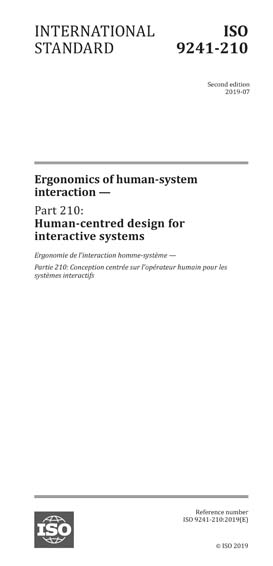Most recent
ISO 9241-210:2019
Ergonomics of human-system interaction - Part 210: Human-centred design for interactive systems
This document provides requirements and recommendations for human-centred design principles and activities throughout the life cycle of computer-based interactive systems. It is intended to be used by those managing design processes, and is concerned with ways in which both hardware and software components of interactive systems can enhance human?system interaction.
NOTE Computer-based interactive systems vary in scale and complexity. Examples include off-the-shelf (shrink-wrap) software products, custom office systems, process control systems, automated banking systems, Web sites and applications, and consumer products such as vending machines, mobile phones and digital television. Throughout this document, such systems are generally referred to as products, systems or services although, for simplicity, sometimes only one term is used.
This document provides an overview of human-centred design activities. It does not provide detailed coverage of the methods and techniques required for human-centred design, nor does it address health or safety aspects in detail. Although it addresses the planning and management of human-centred design, it does not address all aspects of project management.
The information in this document is intended for use by those responsible for planning and managing projects that design and develop interactive systems. It therefore addresses technical human factors and ergonomics issues only to the extent necessary to allow such individuals to understand their relevance and importance in the design process as a whole. It also provides a framework for human factors and usability professionals involved in human-centred design. Detailed human factors/ergonomics, usability and accessibility issues are dealt with more fully in a number of standards including other parts of ISO 9241 (see Annex A) and ISO 6385, which sets out the broad principles of ergonomics.
The requirements and recommendations in this document can benefit all parties involved in human-centred design and development. Annex B provides a checklist that can be used to support claims of conformance with this document.
International Organization for Standardization [iso]


